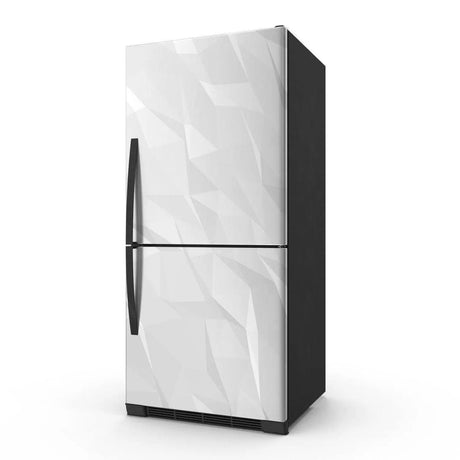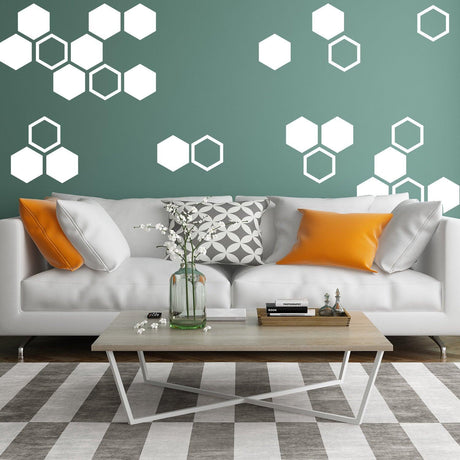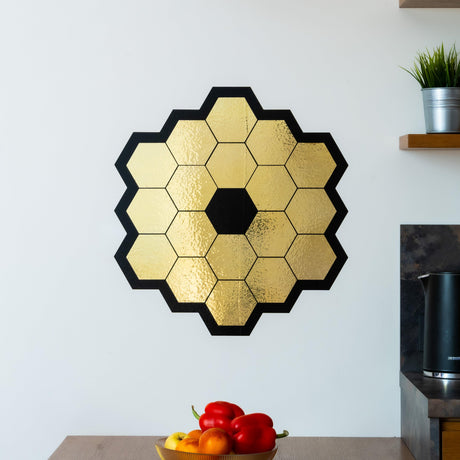A minimalist kitchen does not have to feel empty or cold. Clean lines and simple fronts create space, but they can also leave walls looking unfinished. Wall decals help you add character without breaking the calm rhythm of the room. They sit flush on the surface, do not steal space from countertops and are easy to remove when you change your mind. In this guide you will see how to use minimalist kitchen wall decor with decals, which colors and shapes work best, and how to place and care for them so the room stays bright, tidy and functional.
Why minimalist kitchen wall decor works so well in modern homes
Minimalist design is built on a few clear principles: less visual noise, more function, and a focus on quality over quantity. In the kitchen this usually means flat cabinet fronts, neutral colors and limited accessories on the counter. The downside is that the space can start to look like a showroom rather than a place where people cook and talk.
Minimalist decals give you an extra layer between bare walls and heavy decoration. They add lines, forms and small accents without adding physical objects. Because decals are flat, they do not compete with storage, cooking tools or wall shelves. You get personality on the walls and still leave space for everything you need.
Another advantage is control. You decide exactly where the eye should go. A thin line graphic above the backsplash can lead the view along the worktop. A small group of shapes next to the dining corner can define a cozy zone. Unlike framed art, decals do not require drilling or perfect alignment of hooks. You can move them, test new compositions and remove them without traces if you rent your home.
Minimalist wall decor also helps keep maintenance low. Kitchens collect grease, steam and dust. Open shelves with many objects require constant cleaning. A few simple decals on a clean painted wall or tile backsplash need only a quick wipe with a soft cloth.
How decals fit into a minimalist kitchen layout
In a minimalist space, every element should have a clear job. Decals can frame key areas: the coffee corner, the breakfast bar, the dining nook or the stove wall. They work especially well on empty vertical strips between upper and lower cabinets, on side walls that are visible from the living room, and on the wall around a simple clock or open shelf.
The goal is to support the structure of the room. If your kitchen has strong horizontal lines, you can use long, low graphics to echo them. If the space feels narrow, vertical lines or tall shapes help balance the proportions. Think of decals as quiet guides for the eye, not as loud centerpieces.
Choosing the right surfaces and colors for minimalist decals
Minimalist design depends on clean surfaces. Before you apply any decals, look at your kitchen like a grid of fields: cabinets, backsplash, free wall area, side panels of tall units, fridge front. Decals should land on smooth, stable zones where they can breathe, not get chopped by handles or switches.
The best surfaces are matte or eggshell painted walls, smooth tiles, glass splashbacks and large appliance fronts. Rough plaster or very textured paint can break the clean edges of simple shapes and make them look fuzzy. If you want to use decals on tiles, choose designs that either sit fully inside a tile or intentionally cross many tiles with long lines, instead of stopping in the middle of a grout line.
Color is the next layer. Minimalist kitchens often use white, gray, black, beige and a few accent tones. To keep the atmosphere light, pick one main accent color and limit yourself to it. Graphic black lines on a white wall create a clear, architectural feel. Warm beige or terracotta graphics on white or soft gray invite more warmth. Soft green works well with wood and stone countertops and gives a calm, natural mood.
Avoid mixing too many saturated colors in one small area. Minimalist kitchen wall decor should feel like part of the architecture, not like stickers added at the last second. If you already have strong color in the cabinets, keep decals in one of the neutral tones present in the room.
Which color combinations keep your kitchen calm, not cold
A common fear is that minimalist kitchens look sterile. The key is gentle contrast. Pair white cabinets with warm beige or sand colored decals, not only with sharp black. If your kitchen is dark gray or black, use thin white or soft stone colored lines instead of bright neon tones. Wood worktops and wooden bar stools benefit from muted green or clay colored shapes that echo natural materials.
When in doubt, build a simple palette: one base (white or light gray), one warm accent (wood, beige or soft terracotta) and one dark line color (charcoal or deep brown). Choose decals that stay inside this palette, and the room will feel calm and cohesive.
Ideas for minimalist kitchen wall decor using decals
Minimalist does not mean boring. It means intentional. Decals open many quiet, precise ways to add character. You can work with line art, geometric shapes, small text accents or stylized food and plant motifs.
One approach is linear graphics. Thin, continuous lines that echo the worktop, form an outline around a coffee station or trace a simple abstract wave along the backsplash give rhythm to the wall without drawing too much attention. Another idea is a cluster of small shapes, like circles or dots, placed with generous spacing to form a loose constellation above the dining table.
Stylized icons work well in small zones. Minimal cups and kettles for a coffee bar, forks and spoons near a dining corner, or simple herb silhouettes above a shelf with actual plants. Keep shapes reduced, with little or no shading, so the overall look stays light.
You can also use word decals, but the tone matters. Short, neutral words like “coffee”, “cook”, “gather” in a clean sans serif font fit minimalism. Long quotes and script fonts usually feel busy and do not age well.
After you collect ideas, sketch the layout on paper or take a phone photo of your wall and draw on top of it. This helps you see how much space each idea needs and where it might conflict with cabinets or sockets.
Simple minimalist decal ideas for a kitchen:
- Single line drawings that follow the length of the worktop.
- Small geometric clusters above a breakfast nook or bar.
- Tiny icons that label functional zones such as coffee, tea or spices.
- Stylized herb silhouettes near a shelf with real plants.
Each of these ideas can be built from a few pieces, which keeps installation quick and the final look tidy.
Where to place decals so the kitchen still feels clean
Place decals where the eye naturally rests when you enter the kitchen: the end of a cabinet run, the wall opposite the door, the area above the dining table. Avoid crowding small corners that already have many objects such as knife blocks, utensil jars and open shelves.
Leave empty breathing space around each composition. A simple rule is to keep at least the width of your hand between decals and nearby cabinets, outlets or shelves. This margin helps the design read as intentional and keeps cleaning easy.
How to apply and care for minimalist kitchen decals
Kitchens are working spaces, so decals need a stable base. Before installation, clean the area with a mild degreasing dish soap, rinse with clean water and dry completely. Even a thin film of grease from cooking can weaken the adhesive over time.
Once the wall is dry, mark your layout with painter’s tape or light pencil lines. This step is especially important for minimalist designs because misaligned straight lines stand out immediately. Check the composition from a distance and from the angle where you usually see the wall, for example from the living room sofa or dining table.
When you are satisfied with the layout, apply the decals slowly.
Basic steps for applying kitchen wall decals:
- Start with the central or longest piece to anchor the design.
- Peel back a small section of the backing and align the decal with your tape guides.
- Fix the top edge lightly, then peel the rest of the backing while smoothing the decal downward.
- Use a soft cloth or squeegee to push out air bubbles from the center to the edges.
- Add smaller pieces around the main element, checking alignment as you go.
After application, avoid wiping the decals for at least a day so the adhesive can set. Later, clean them with a soft cloth and mild soap. Do not use abrasive sponges or sharp tools on the film.
In cooking zones, steam and small splashes are normal, but direct contact with strong heat is not ideal. Keep decals away from open flames and very hot surfaces such as the side of a gas range without a protective panel.
Common mistakes to avoid when using decals in kitchens
Several problems repeat in kitchens. Applying decals on greasy paint or directly above an active cooking area often leads to lifting edges. Placing graphic lines where they are constantly hit by pots, chairs or cupboard doors also shortens their life.
Another mistake is cluttering every empty wall. Minimalist kitchen wall decor works best when you choose one or two focus zones and leave the rest simple. Finally, avoid trimming decals tightly around sockets or switches. Small irregular cuts break the clean look and create weak points where the film can start to peel.
Buying guide: how to pick minimalist kitchen wall decor on Decords
When you browse Decords, start with the bigger picture. Decide which wall needs attention and what role the decals will play there: subtle frame, focal line, or small accent. Then filter the selection toward clean, simple designs with consistent line weight and limited colors.
Product photos show scale, but always read the measurements as well. A graphic that looks small on screen might cover most of your backsplash in real life. Measure the wall or cabinet front and compare it to the listed sizes. For long counters, it is useful to choose designs that you can repeat or extend, such as modular line segments or small clusters.
Material details are important too. Look for decals made from high quality removable vinyl with a matte or low sheen finish. This type of surface blends better with paint and cabinet fronts and hides fingerprints better than high gloss. If the description mentions easy removal without residue, the product suits renters and anyone who likes to refresh their space regularly.
Before you place an order, run through a short checklist.
Checklist before ordering minimalist kitchen wall decals:
- The design matches your cabinet style and overall color palette.
- Sizes are clear and fit the wall, backsplash or appliance front you want to decorate.
- The film is removable vinyl suitable for painted walls, tiles or metal.
- The finish (matte or low sheen) supports a calm, minimalist look.
- You can combine this set with others from the same range if you expand later.
Once the decals arrive, take time to plan the layout instead of rushing into application. Minimalist decor is all about precise decisions. A few well placed shapes will do more for your kitchen than a wall full of competing elements.
















